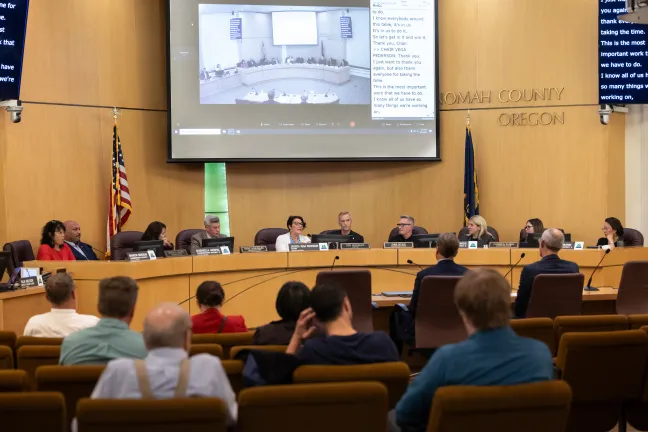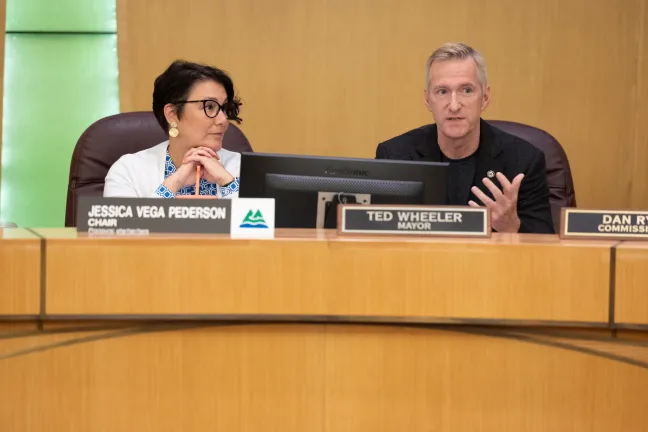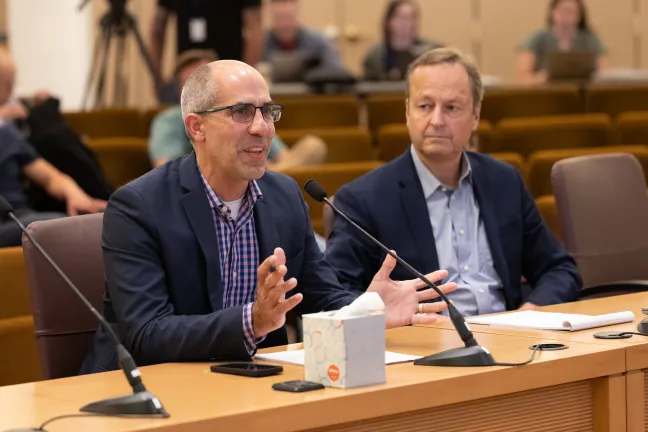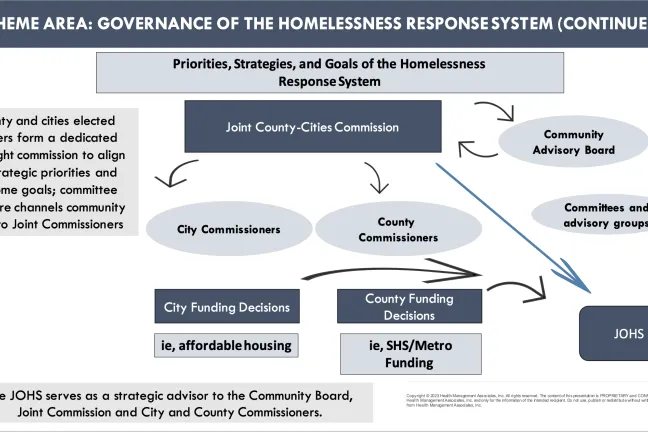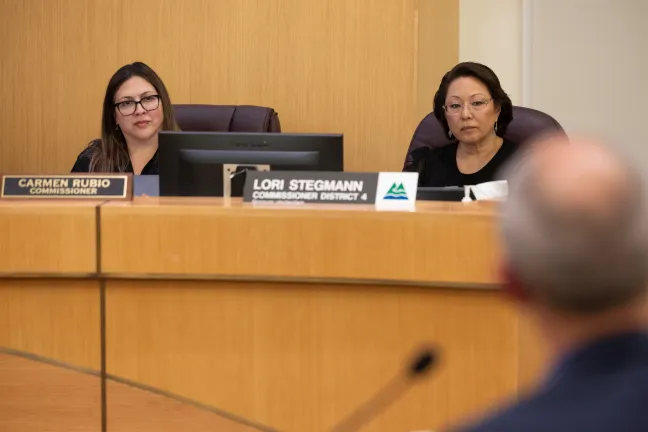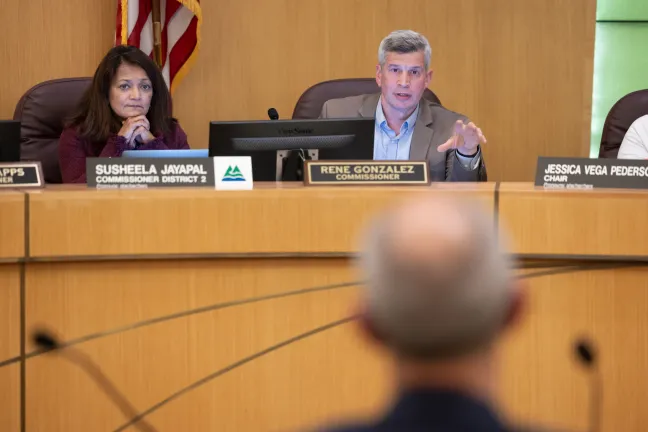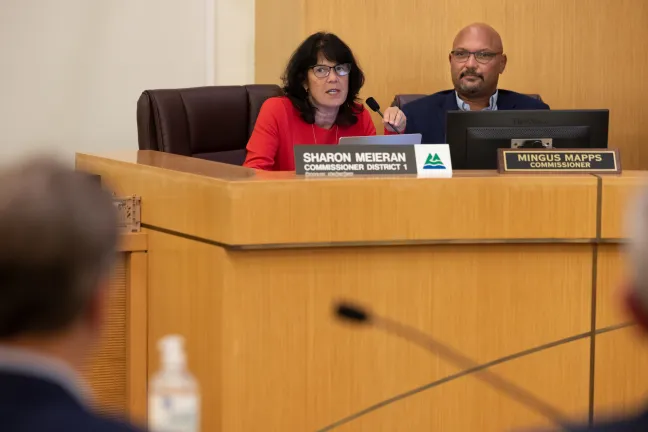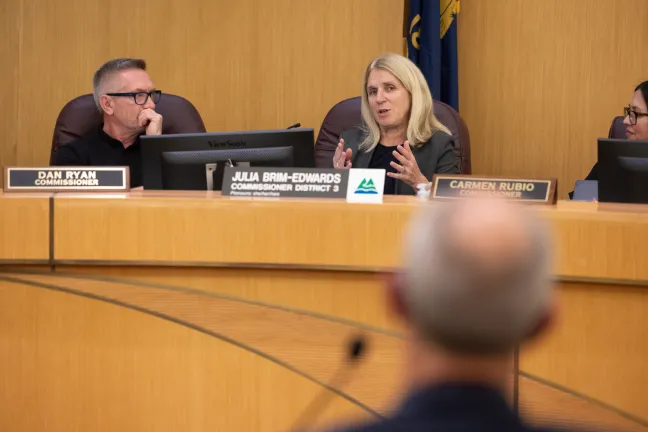In a demonstration of partnership, the Multnomah County Board of Commissioners and the Portland City Council met in a joint session on Friday, Sept. 22, for the first public unveiling of a third-party review analyzing current issues with the Joint Office of Homeless Services and the region’s overall response to homelessness.
“Today is about our collaboration, engagement, and partnership, as we convene for the first in-person joint session of our two governments since at least 2019,” Chair Jessica Vega Pederson said. “We're here to discuss not only our shared work on combating homelessness through the Joint Office of Homeless Services, but also the opportunity before us to improve our entire homelessness response system.”
Recommendations for how to strengthen that partnership — building on efforts undertaken this year by Chair Jessica Vega Pederson and Portland Mayor Ted Wheeler — are key elements in the review prepared by Health Management Associates of Oregon (HMA), the consulting firm contracted by the County to conduct the review.
The recommendations outlined by HMA include creating a new governance model to provide oversight and policy direction for the Joint Office, clarifying the City and County’s roles, and joining together to create a shared strategic vision and map for the region’s homeless response system.
“We must improve the operations and systems of the Joint Office to build and execute a system of care for all Portlanders, especially those who are most vulnerable. I think we all agree on that,” Wheeler said. “This is an opportunity for us to truly connect all of our resources together, to create a true continuum of care that prioritizes those living on our streets, to maintain public safety, and to keep our public spaces accessible and clean.”
The recommendations were drawn from interviews with City and County elected officials, community nonprofits and others. And they arrive as the County and City work to renegotiate the intergovernmental contract that created the Joint Office in July 2016.
Dan Field, who was hired this spring as the Joint Office’s first permanent director in more than a year, was directed by Vega Pederson and Wheeler to build a more effective and efficient Joint Office — which has had to balance workforce challenges and a life-saving COVID-19 pandemic response while growing with a massive infusion of Supportive Housing Services funds.
Field worked to secure the review by Health Management Associates of Oregon as soon as he was on board, with the goal of guiding and shaping his leadership strategy. Health Management Associates is an independent, national firm that specializes in improving publicly funded health care and human services programs.
Following the briefing, next steps in partnership with Health Management Associates of Oregon include sharing findings with service providers and Joint Office staff, and developing work plans for all themes identified for improvement.
HMA shares findings and recommendations
Beyond laying out ideas for enhancing the County and City’s working relationship, the review identifies service and management gaps to address — while also validating and reinforcing ongoing systems, communications and data improvement work underway by the Joint Office, as noted in the department’s response to a recent County audit.
James Schroeder, the managing principal at HMA, framed the recommendations by highlighting the optimism he heard in his interviews.
“We spend a lot of time talking about what we need to do better. But there was a lot of hope and energy around what comes next,” Schroeder said. “We believe there's a path forward and that we can do this together.”
The recommendations presented by Schroeder focused on seven key thematic areas:
- Homelessness Response System
- Governance/Leadership
- Provider Payment/Relations
- Housing and Other System Integration
- Communication
- Role and Function of JOHS
- Coordinated Access/Entry
For each identified theme, Schroeder outlined HMA’s findings, and then shared recommendations as part of an overarching action plan that HMA will work to develop with the County and City.
The Homelessness Response System
HMA identified a gap in alignment among elected leaders, County staff, and service and housing providers about the best ways to respond to homelessness.
To resolve this, HMA recommended a long-term strategy to allow leadership to better align on key components of the system and also to work together to identify and fill gaps.
HMA recommended leaders begin by focusing on two objectives: Creating a community-wide strategy for shelter, and creating and a community-wide strategy for serving medically fragile people, including those living with behavioral health challenges and substance use disorders.
Schroeder said that both of those action items build upon key concerns raised in HMA’s interviews, while still being doable in the short-term.
Governance/Leadership
HMA determined that the current governance model for the homelessness response system is ineffective. “We don't have the strategy and vision, and we don't really have the governance model even if we did,” Schroeder said.
Until 2021, the Joint Office, the County and the City were advised by a joint body called A Home for Everyone, which saw community members and elected officials, including the County Chair and Mayor, vote in public meetings to recommend budget and policy priorities for the Joint Office to the City Council and Board of Commissioners. A Home for Everyone was sunset, and the Joint Office instead expanded the number of advisory groups it works with.
Schroeder said that there were flaws with the A Home for Everyone model, but that there is still a desire for a joint governance model.
“I was surprised how much the A Home For Everyone Board dissolving came up [in interviews],” Schroeder said. “Iit was a lack and a missing piece for everyone when it was dissolved. And a big desire for us to come up with something else and not just have that void continue.”
To solve the issues with governance, HMA’s recommendations include creating a new governance model jointly run by the City and County, and improving the community advisory structure so that the community has clear channels for feedback.
For that new governance model, HMA recommended it be a truly joint model between the City and County that would shape the vision and strategies of the Joint Office. HMA recommends the County continue to serve as the “lead agency,” with the Joint Office remaining a County department for functions like human resources, payroll, legal services, information technology and other back-office needs.
Provider Payment/Provider Relations
HMA also found barriers in the Joint Office’s current funding policies and procedures.
Schroeder said current reimbursement rates for providers do not cover the total costs of providing services across an organization — a result of a long-running practice that predated the Joint Office in which providers would also fund work outside their contracts with the City and County with philanthropic dollars.
“That may have been the right thing when we had a smaller amount of dollars,” Schroeder said. “But there are not enough philanthropic resources at the level that we're asking them to match. And that is getting in the way of providers being able to move forward in the way that we need them to.”
HMA recommends the Joint Office continue its ongoing work revamping its invoicing process, assess its existing contracting process, develop a more inclusive process for determining funding priorities before releasing funding announcements, rebase rates for services, and conduct a comprehensive review and redesign of funding policies and processes.
That last recommendation could include changing how the Joint Office reimburses providers for delivering services — including changing the current practice of requiring providers to submit invoices for the costs they’ve incurred after they’ve begun delivering services, which can be a strain on smaller providers.
An additional recommendation HMA provided was for the Joint Office to serve as a strategic leader and thought partner.
“It’s 55 different providers. They do a lot of different things, they don't have a convening place to get together. So the Joint Office could create that for them,” Schroeder said.
Housing and Other System Integration
HMA’s findings indicated that the various systems that people experiencing homelessness may come in contact with — housing, healthcare, criminal justice, education — are largely siloed, leading to fragmented care for clients and, often, returns to homelessness and poor outcomes.
“There’s just a lot of work that we need to do to integrate not just the Joint Office, but our housing continuum,” Schroeder said. “It’s going to take more than the Joint Office, the City, and the County. It's a much wider swath.”
For this area, HMA provided the high-level recommendation of identifying and developing key relationships and integration with other key partners and systems. Schroeder said the first step is integrating the Joint Office’s work with other existing County departments.
“The County needs to work on integrating behavioral health and the things that are within its own walls,” Schroeder said. “Not that that work isn't under way, and that there isn't some level of integration, but it's got to go further. That will pull in healthcare, it will pull in the state, it will pull in a number of partners. That will give more practice on integrating with them.”
Communication
HMA said communication issues were a universal concern among interview participants.
Schroeder said that communication challenges existed at all levels: internally in the Joint Office, and externally with providers, elected officials, community members.
HMA’s recommendations include the Joint Office developing a proactive and responsive communication strategy, and establishing processes that are sharing clear strategies, priorities and the measurable progress toward achieving key outcomes. Those metrics and strategies should serve as the necessary base to build improved public communications, Schroeder said.
“Timeliness, transparency, data-driven, measurable outcomes that we're going after — those are all pieces of communication,” he said.
Role, Function and Structure of JOHS
HMA found that the Joint Office’s rapid growth over the past couple of years — from a staff of 30 to more than 100, reflecting an expansion in work through funding from the Supportive Housing Services Measure and other budget investments — have led to structural challenges.
“Some of the things that needed to be built structure-wise with that growth just didn't happen,” Schroeder said. “And now we need to work to get it to where it needs to be.”
HMA recommends clarifying roles and responsibilities, implementing consistent standards in provider contracts, and developing a “system blueprint” for the department.
Coordinated Access/Entry
HMA found that the Coordinated Access process, which is a tool required by the U.S. Department of Housing and Urban Development for helping the most vulnerable people in a community access supportive housing, has fallen short of policy and operational objectives.
“It’s driving inequity in our outcomes. It is a big thing that we need to look at,” Schroeder said. He acknowledged that this is work already underway at the Joint Office, which has been proactively working to redesign the assessment tool in part to make it easier to navigate and also to better reflect the experiences of people of color.
Elected officials share thoughts on recommendations
All 10 elected officials in attendance had time to ask questions and share their feedback. Many expressed optimism about the work ahead.
Commissioner Lori Stegmann said she agreed with HMA’s recommendation to consider other reimbursement models.
“Not all of our service providers are huge nonprofits. Many of them are very, very small,” Stegmann said.
She said some smaller nonprofits may not have the funding to pay for services upfront and wait to be reimbursed.
“I know as a small business owner, you need to get that income because you have bills to pay,” she said.
Several officials highlighted the report’s focus on immediate action for medically fragile people. City Commissioner Dan Ryan asked Schroeder why the report focused on that population.
Schroeder said providers described increasing acuity — more severe medical and behavioral health issues — among the clients they serve. “Our housing providers are being asked to care for people who aren't medically at a place where they should be in the hospital, but they shouldn't be alone in housing either,” Schroeder said.
Ryan said providing a suite of solutions that focus on different populations — including those experiencing homelessness for purely financial reasons, and those whose homelessness is compounded with behavioral health challenges — will allow the City and County to respond more effectively.
“I don't think we do a good enough job differentiating between those two basics. We aren't on the same page and our arrows aren't aligned. And I think we need to get on the same page about the language and who we're actually serving out there,” Ryan said.
City Commissioner Rene Gonzalez said part of the work will be determining what the Joint Office can realistically accomplish given the multiple crises experienced in the community.
“I think we need to make some space to define what is the Joint Office’s responsibility. We have a behavioral health crisis in our state that is 50 years in the making. And I'm not sure the Joint Office is going to solve that problem,” Gonzalez said. “So defining what this body's responsibility is, what's the County's responsibility, and what’s the state’s responsibility, I think is going to be part of how we define goals and success here.”
Gonzalez said the outlined recommendations to prioritize strategies for shelter and serving the medically fragile — specifically, people experiencing behavioral health challenges and substance use disorders — would affect his critical view of the Joint Office. “If we can show everyday Portlanders progress on shelter and the medically fragile, you're going to get some leeway from me,” he said.
City Commissioner Mingus Mapps said he did not agree with the governance and management models suggested by HMA, particularly the recommendation that the Joint Office remain a County department.
“When I look at this, I don't really understand what's ‘joint’ about this. I don't see the City in here,” he said.
Schroeder explained that in HMA’s recommendations, the City and County would jointly determine the vision and strategies of the Joint Office, but that it would continue to be a County department, with day-to-day operations led by, and back-office functions provided by, the County.
“What a number of places have done, where they do come together as a City and County, they have what's called a ‘lead entity.’ And so that's where this model is,” Schroeder said. “So you're separating who's driving strategy and priorities from the day-to-day operations.”
Mapps said he disagreed with that governance model — and with the very existence of the Joint Office.
“My proposal is that, frankly, we move past the Joint Office,” he said, noting he would maintain current investments and service levels, but do that “through a series of intergovernmental agreements that clearly defines what the City is expecting and clearly defines what the County is expecting.”
County Commissioner Sharon Meieran said she was glad the report highlighted ongoing issues with the Joint Office and opportunities for improvement.
“I'm going to try to have hope here today, because daylight has been let in, and the glaring dysfunction can't be swept under the rug anymore,” Meieran said. “ We need to take action. And I hope we will be coming together truly to do that.”
Several of the leaders said they appreciated the focus on aligning around priorities and solutions.
County Commissioner Susheela Jayapal cited a lack of alignment as one reason the Joint Office has experienced challenges.
“We as elected officials have not been aligned. We as jurisdictions have not been aligned. Disagreement is going to happen, but we do need to figure out how we jointly work through the disagreement, make some compromises, and present the community with an aligned path forward,” Jayapal said. “That lack of alignment has led to confusion. It's led to a politicization of these issues that has not been helpful, and in fact, has been harmful to the work itself.”
County Commissioner Julia Brim-Edwards said that shared alignment, and a shared governance model, are key.
“I fundamentally believe that a strong and effective partnership between the City and the County is really essential if we're going to be able to address our biggest issues,” she said. “It's going to, in some ways, be a little messy, because there are places where it's not absolutely clear what our roles are, who has the funding, or who has the expertise. But I do think for us to achieve the results that we want together, we need to better understand what our roles and responsibilities are.”
City Commissioner Carmen Rubio also highlighted the joint governance model. “So we have more shared ownership of the conversation and the decisions that move forward — I like that idea,” she said, noting the start made just by having elected leaders sitting side by side hearing the same information at the same time.
“The fact of us getting together is a big, important step forward to show our alignment and the ways we are working together, the ways that we have more work to do,” she said.
Wheeler agreed the City and County must continue working together, and that doing so will require being upfront about priorities, something that he said leaders have previously shied away from.
“The public expects us to work together,” Wheeler said. “We do not all hold all of the span of control, the streams of funding, or the expertise, to be able to solve this problem independently.”
Vega Pederson said the work ahead will be challenging, but that she was hopeful. “This is an opportunity for us to prove that we can function together well. I believe that we can do it. But we have hard work before us. It is going to be uncomfortable. There is going to be disagreement,” she said. “But I think we're all better for it. And we do have people who are willing to be, and want to be, part of the solution with us in addressing this problem.”
She thanked the other elected officials for their shared engagement with the work. “I am committed to this, and I'm glad you're committed to this, too.”
